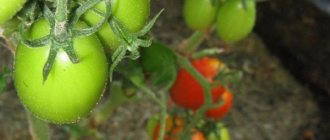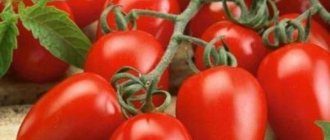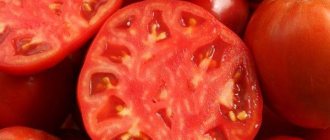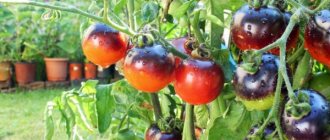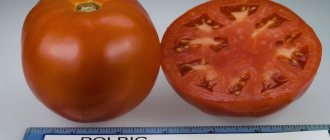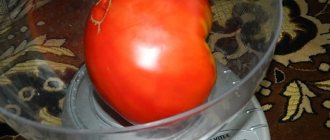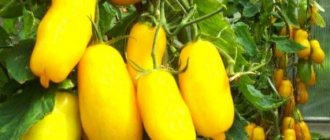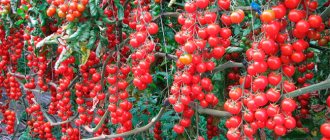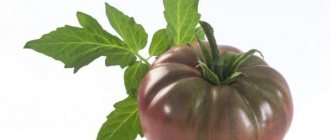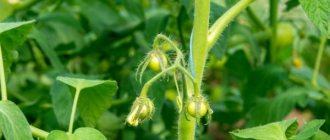The Far North tomato will be the best choice for planting, especially in regions of risky farming. After all, it was bred taking into account all the factors affecting the growth and fruiting of a tomato.
The Far North tomato is a variety created on the basis of the St. Petersburg regional public organization "Union of Seed Producers" with the direct participation of one of its divisions - the Biotechnika association.
When carrying out selection work, specialists took into account the climatic features of all regions of Russia.
Test cultivations yielded high results in all regions, even in Siberian conditions. It was these factors that prompted breeders to name the tomato variety – Far North.
By mid-2007, the tomato was included in the State Register of Approved Seeds, where the possibility of growing this variety in all regions of the Russian Federation was stated.
Description of tomato Far North
The Far North tomato bush forms a small root system, which corresponds to the standard form of the plant. With a limited growing point not exceeding 65 centimeters, this variety is classified as a determinate plant.
The trunk of the plant is quite strong and leafy. The leaf blade of the Far North tomato is closer to medium in size and has a rich green color. The tomato inflorescence is unbranched and short (up to 6 fruits in a cluster). The latter is formed at the very top of the bush.
In terms of ripening time, the Far North variety is considered early ripening - no more than 85 days pass from the emergence of seedlings to the harvesting of the first ripe fruits.
Description of fruits
The fruits of the Far North tomato are slightly ribbed in shape in the first clusters, weighing 100 g. All subsequent clusters bear absolutely smooth tomatoes weighing no more than 70 g.
This weight of fruits in determinate tomato bushes belongs to the category of medium-fruited, which, in turn, allows us to talk about a large number of chambers (nests) inside the fruit - from 4 to 6.
Unripe tomatoes are colored milky green, and when they reach biological maturity they acquire a rich red hue. According to reviews from vegetable growers, Far North tomatoes have a traditional tomato taste with the presence of mild sourness.
Characteristics of the variety
Photos and reviews from vegetable growers who have been successfully planting Far North tomatoes for a long time allow us to obtain the main characteristics characteristic of this particular variety.
Productivity and fruiting
The tomato is an early ripening plant; thanks to this feature, you can begin picking fresh fruits by mid-July. The tomatoes ripen together. The fruits are perfectly separated from the stalk and do not crack.
A good factor in increasing the yield of the Far North tomato, judging by the photos and reviews of farming enthusiasts, is thickened planting, which allows you to harvest a fairly impressive harvest. When carrying out interval planting (40 cm by 60 cm), the yield from 1 bush is about 1.5 kg. When planting using the thickened method (up to 8 bushes per 1 square meter), up to 16 kg of tomatoes can be harvested from this area.
The originators declared the possibility of growing this variety both in open ground and in greenhouses. According to reviews from amateur vegetable growers, the Far North tomato is capable of producing excellent fruit in equipped greenhouses and in potted plants at home.
Important! Far North tomato seeds can be grown without seedlings.
Area of application of fruits
The early ripeness of the variety allows the fruits to be used for preparing fresh vegetable salads and decorating finished culinary masterpieces. Thanks to the thick skin, the tomatoes do not drain during cooking, and it also allows them to be used for winter preservation.
Resistance to diseases and pests
The originators of the variety took care of the resistance of this nightshade crop to dampness, which, in turn, does not allow putrefactive diseases such as root and crown rot to appear. And early ripeness and determinacy allows you to harvest the entire crop before late blight develops.
Pests that can attack tomato bushes will have to be fought.
Advantages and disadvantages of the variety
The Far North has become popular due to a huge number of positive qualities:
- precocity;
- cold resistance;
- unpretentiousness;
- amicable maturation;
- versatility;
- resistance to fungal diseases;
- transportability.
Such a large number of advantages covers up some of the negative qualities of these tomatoes, which are mostly highlighted by novice farming enthusiasts:
- low yield;
- lack of complete sweetness in taste.
These characteristics cannot be considered disadvantages, because you should not expect high yields from low-growing tomato bushes, and there is no point in arguing about the taste characteristics.
Advantages and disadvantages of the variety
The main advantage of Far North tomatoes is their good adaptation qualities. The bushes tolerate short-term drops in temperature, which allows them to be grown even in unfavorable conditions. To increase the yield, it is desirable to cultivate in a greenhouse.
Far North tomatoes ripen quite quickly and amicably
pros
- good adaptability to unfavorable climatic conditions;
- disease resistance;
- precocity;
- universal purpose of fruits;
- long-lasting shelf life and transportability;
- easy to care for - no need to form bushes and tie them to supports.
Minuses
- low yield;
- the taste is not sweet enough, the flesh is dense.
Growing rules
This variety of tomatoes can be grown in seedlings and without seedlings. When planting without seedlings, the seeds are planted immediately in open ground under a film cover.
We should dwell in more detail on growing seedlings at home.
Planting seedlings
You can plant seeds in a purchased substrate, but it is better to make your own seedling soil mixture.
To prepare the substrate you will need three components:
- Garden soil, pre-heat-treated.
- Agroperlite.
- Vermiculite.
Strictly observing the proportions (5 parts soil, 1 part agroperlite, 1 part vermiculite), all components must be mixed until a homogeneous substance is formed.
Further preparation of the substrate is carried out with fungicidal preparations to eliminate the most common disease of seedlings - blackleg.
2 weeks before planting the seeds, the substrate is spilled with the drug Maxim (2 ml per 5 liters of water). 9 days after treatment, the substrate is treated with phytosporin (1.5 tablespoons of working solution per 10 liters of water).
Planting of the Far North variety should begin in the first ten days of April. It is better to plant seeds one at a time in different containers. Since the root system of low-growing tomato varieties is poorly developed, this method of planting will avoid injury to the roots during picking of seedlings.
For planting, a good solution would be to use peat tablets and disposable plastic cups.
Peat tablets are pre-soaked, and the substrate in glasses is spilled with warm water (50°C, no more). The seeds are laid out on the surface; to stimulate germination, a stimulator should be dropped onto them with a pipette - 1 drop per 1 seed.
Important! To prepare a stimulant solution, you will need 2 drops of Zircon, diluted in 100 ml of water.
Sprinkle the seeds on top with a small amount of soil (no more than 2 cm). The next step is to create greenhouse conditions for better seed germination. To do this, the glasses must be covered with polyethylene and placed in a warm, well-lit place. After 5 days, the first shoots appear.
As soon as the first loops appear, it is necessary to remove the covering material and place the glasses in a cooler room (not higher than 16 ° C) until the first true leaf appears.
Important! If group sowing of seeds was carried out, then it is necessary to pick the seedlings in the phase of one, maximum two, true leaves using the transshipment method.
10 days before planting seedlings in the ground, it is necessary to fertilize with a mineral complex fertilizer (NPK20:20:20) or a specialized composition for seedlings, strictly following the instructions.
Transfer
You can plant ready-made seedlings in the garden in the last days of May. If you plan to plant in a greenhouse, then you can plant it 1 week earlier.
Important! You should not choose places for planting where representatives of nightshade crops grew last season - potatoes, peppers, eggplants.
Each gardener chooses the planting method himself:
- measured landing according to the pattern 40 cm by 60 cm;
- compacted planting - 8 seedlings per 1 sq. m.
The variety is unpretentious in terms of growing conditions, but the plant will do better in sunnier areas.
Aftercare
During the first week, it is necessary to water the seedlings every two days in the evening, strictly at the root. Water for irrigation should be approximately room temperature. 7-10 days after planting in the ground, the seedlings must be fed with complex fertilizer, after which the soil must be mulched. You can use sawdust or straw as mulch. Mulch will prevent the soil from drying out and protect the root system.
The Far North tomato does not require special care. The standard form of the plant at the genetic level is not capable of forming stepsons, which makes it possible to omit this procedure when subsequently caring for the bushes.
There is no need to tie up the bush either - the tomato has a fairly strong trunk that can withstand the weight of all the fruits that have set.
Reviews from gardeners about the Far North variety
I just love tomatoes. This is an indispensable vegetable in my area. Every year I grow Far North tomatoes from Agronika seeds. These tomatoes are very tasty, juicy and sweet. They contain a lot of healthy sugars, fiber, and minerals. I liked this variety for its high yield and fast fruit set. Tomatoes ripen very quickly. This is especially true for the northern regions of our country. In our Volgograd region, this plant grows beautifully and pleases me with large and tasty fruits all season long. I collect the first fruits from the bush within 3 months from the moment the plant is planted in the soil. Tomatoes of this variety tolerate cold weather well. Therefore, I plant some of the plants in open ground in mid-August. For safety, I cover them with a double layer of thick spunbond. This variety produces its fruits quickly. Therefore, it is less affected by viral diseases. And this helps to increase the yield. Far North tomatoes are good fresh. I make salads from them and add them when preparing first and second courses. The fruits have a thick skin. They are well stored and transported over long distances.
tutsa
https://otzovik.com/review_4621748.html
I can recommend the proven variety “Far North”. It was the name that first of all attracted my attention, and only then, having familiarized myself with the characteristics of the variety, it was decided to try it at the dacha. I grow this tomato in open ground. From the first shoots to the fruits is about three months, that is, it ripens at the end of July, and the harvest is in August. I would like to say a little about this tomato. This is a standard variety, height is approximately 40 cm. It is unpretentious and gives a good harvest. The fruit itself is flat and round in shape, red. Pinching is not necessary, but is done to obtain an early harvest. Caring for the “Far North” variety is simple. This is a standard plant, it is being formed. During formation, you need to tie it up; I usually install stakes next to the bole. As I already said, stepsoning is not necessary, although it is not denied. I water it once a week, well, at the root. The main thing is that water does not get on the leaves and stems. Fertilizers - of course. By the way, due to its early ripening property, it is not affected by late blight.
bigsev
https://www.agroxxi.ru/forum/topic/6225-%D0%BE%D0%B1%D1%81%D1%83%D0%B4%D0%B8%D0%BC-%D0%BD% D0%B0-%D1%84%D0%BE%D1%80%D1%83%D0%BC%D0%B5-%D1%82%D0%BE%D0%BC%D0%B0%D1%82% D0%BE%D0%B2%D0%BE%D0%B4%D0%BE%D0%B2-%D0%BB%D1%8E%D0%B1%D0%B8%D1%82%D0%B5%D0 %BB%D0%B5%D0%B9-%D1%81%D0%BE%D1%80%D1%82%D0%B0/
That year I planted the Far North (a large garden bed in the region) - I really liked it! Both unpretentious and productive. But it bushes a lot, so don’t plant the bushes close to each other!
mamaboysekb
https://www.u-mama.ru/forum/family/dacha/573560/
I also like the Far North tomato. In our conditions of the Far North, it can be grown in open ground. It is very resistant to low temperatures, early ripening (therefore it does not suffer from FF) - it began to ripen for me at the end of July. It's a standard one (you can plant it more densely), it's grown to about 45 cm, there's no need to pin it down. The fruits are 80 grams, red, sour in taste, but I love this taste.
tania 711
https://dacha.wcb.ru/lofiversion/index.php?t54252.html
I raised 4 hybrids: - Junior F1 (NK), Buyan F1 (NK), Ultra-early ripening F1 (Elite-garden, Novosibirsk), Far North F1 (Elita-garden, Novosibirsk). All are good for canning, all have thick skin, non-fleshy flesh, and are medium in size. In terms of taste, I liked Buyan (thin walls, sweet and sour) and Far North (pronounced “tomato” aroma and taste, the fruits are round, small, dark green with yellowness at the top) the most. In terms of cultivation, the Far North is the most unpretentious of all, of course. The seedlings are very strong and grow into compact, neat bushes up to 40 cm high. I didn’t do anything with them at all, only feeding them occasionally and watering them. The fruits are small and plentiful. In general, it resembles a small tree with fruits.
Alencha
https://forum.tvoysad.ru/viewtopic.php?t=6831&start=45
Not only experienced summer residents, but also novice gardeners will not have problems growing Far North tomatoes: it is enough to properly prepare the seeds, regularly water, loosen and weed the plant. If gardeners are not chasing high yields, then they do not tie up or prun the bushes: this does not affect the taste and quality of the tomatoes.
Pest and disease control
Although the Far North tomato is not susceptible to diseases characteristic of the nightshade crop, for preventive purposes it is better to treat it with a biofungicide once every 20 days. The solution is prepared by diluting 15 g of phytosporin working solution in 10 liters of water.
Pests are a little more complicated. You can cope with them using the following acaricidal drugs:
- Aktara;
- Inta-Vir;
- Decis-Profi;
- Actellik.
Treatment with acaricides should be carried out in the morning or evening, in dry and windless weather.
